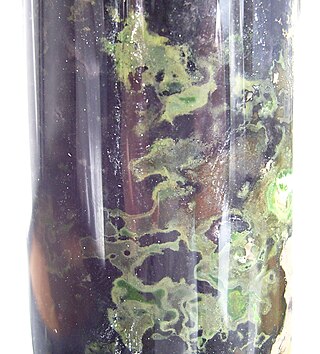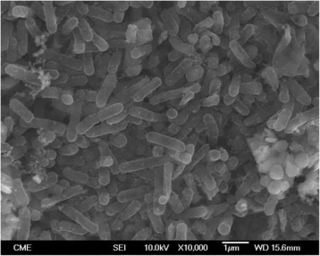
The green sulfur bacteria are a phylum, Chlorobiota, of obligately anaerobic photoautotrophic bacteria that metabolize sulfur.
The Aquificota phylum is a diverse collection of bacteria that live in harsh environmental settings. The name Aquificota was given to this phylum based on an early genus identified within this group, Aquifex, which is able to produce water by oxidizing hydrogen. They have been found in springs, pools, and oceans. They are autotrophs, and are the primary carbon fixers in their environments. These bacteria are Gram-negative, non-spore-forming rods. They are true bacteria as opposed to the other inhabitants of extreme environments, the Archaea.
The Thermomicrobia is a group of thermophilic green non-sulfur bacteria. Based on species Thermomicrobium roseum and Sphaerobacter thermophilus, this bacteria class has the following description:
"Aquifex aeolicus" is a chemolithoautotrophic, Gram-negative, motile, hyperthermophilic bacterium. "A. aeolicus" is generally rod-shaped with an approximate length of 2.0-6.0μm and a diameter of 0.4-0.5μm. "A. aeolicus" is neither validly nor effectively published and, having no standing in nomenclature, should be styled in quotation marks. It is one of a handful of species in the Aquificota phylum, an unusual group of thermophilic bacteria that are thought to be some of the oldest species of bacteria, related to filamentous bacteria first observed at the turn of the century. "A. aeolicus" is also believed to be one of the earliest diverging species of thermophilic bacteria. "A. aeolicus" grows best in water between 85 °C and 95 °C, and can be found near underwater volcanoes or hot springs. It requires oxygen to survive but has been found to grow optimally under microaerophilic conditions. Due to its high stability against high temperature and lack of oxygen, "A. aeolicus" is a good candidate for biotechnological applications as it is believed to have potential to be used as hydrogenases in an attractive H2/O2 biofuel cell, replacing chemical catalysts. This can be useful for improving industrial processes.
Aquifex pyrophilus is a gram-negative, non-spore forming, rod-shaped bacteria. It is one of a handful of species in the Aquificota phylum, which are a group of thermophilic bacteria that are found near underwater volcanoes or hot springs.

Nitrosomonas is a genus of Gram-negative bacteria, belonging to the Betaproteobacteria. It is one of the five genera of ammonia-oxidizing bacteria and, as an obligate chemolithoautotroph, uses ammonia as an energy source and carbon dioxide as a carbon source in presence of oxygen. Nitrosomonas are important in the global biogeochemical nitrogen cycle, since they increase the bioavailability of nitrogen to plants and in the denitrification, which is important for the release of nitrous oxide, a powerful greenhouse gas. This microbe is photophobic, and usually generate a biofilm matrix, or form clumps with other microbes, to avoid light. Nitrosomonas can be divided into six lineages: the first one includes the species Nitrosomonas europea, Nitrosomonas eutropha, Nitrosomonas halophila, and Nitrosomonas mobilis. The second lineage presents the species Nitrosomonas communis, N. sp. I and N. sp. II, meanwhile the third lineage includes only Nitrosomonas nitrosa. The fourth lineage includes the species Nitrosomonas ureae and Nitrosomonas oligotropha and the fifth and sixth lineages include the species Nitrosomonas marina, N. sp. III, Nitrosomonas estuarii and Nitrosomonas cryotolerans.
Sulfur-reducing bacteria are microorganisms able to reduce elemental sulfur (S0) to hydrogen sulfide (H2S). These microbes use inorganic sulfur compounds as electron acceptors to sustain several activities such as respiration, conserving energy and growth, in absence of oxygen. The final product of these processes, sulfide, has a considerable influence on the chemistry of the environment and, in addition, is used as electron donor for a large variety of microbial metabolisms. Several types of bacteria and many non-methanogenic archaea can reduce sulfur. Microbial sulfur reduction was already shown in early studies, which highlighted the first proof of S0 reduction in a vibrioid bacterium from mud, with sulfur as electron acceptor and H
2 as electron donor. The first pure cultured species of sulfur-reducing bacteria, Desulfuromonas acetoxidans, was discovered in 1976 and described by Pfennig Norbert and Biebel Hanno as an anaerobic sulfur-reducing and acetate-oxidizing bacterium, not able to reduce sulfate. Only few taxa are true sulfur-reducing bacteria, using sulfur reduction as the only or main catabolic reaction. Normally, they couple this reaction with the oxidation of acetate, succinate or other organic compounds. In general, sulfate-reducing bacteria are able to use both sulfate and elemental sulfur as electron acceptors. Thanks to its abundancy and thermodynamic stability, sulfate is the most studied electron acceptor for anaerobic respiration that involves sulfur compounds. Elemental sulfur, however, is very abundant and important, especially in deep-sea hydrothermal vents, hot springs and other extreme environments, making its isolation more difficult. Some bacteria – such as Proteus, Campylobacter, Pseudomonas and Salmonella – have the ability to reduce sulfur, but can also use oxygen and other terminal electron acceptors.
Thermus thermophilus is a Gram-negative bacterium used in a range of biotechnological applications, including as a model organism for genetic manipulation, structural genomics, and systems biology. The bacterium is extremely thermophilic, with an optimal growth temperature of about 65 °C (149 °F). Thermus thermophilus was originally isolated from a thermal vent within a hot spring in Izu, Japan by Tairo Oshima and Kazutomo Imahori. The organism has also been found to be important in the degradation of organic materials in the thermogenic phase of composting. T. thermophilus is classified into several strains, of which HB8 and HB27 are the most commonly used in laboratory environments. Genome analyses of these strains were independently completed in 2004.
Hydrogen-oxidizing bacteria are a group of facultative autotrophs that can use hydrogen as an electron donor. They can be divided into aerobes and anaerobes. The former use hydrogen as an electron donor and oxygen as an acceptor while the latter use sulphate or nitrogen dioxide as electron acceptors. Species of both types have been isolated from a variety of environments, including fresh waters, sediments, soils, activated sludge, hot springs, hydrothermal vents and percolating water.

Thermotoga maritima is a hyperthermophilic, anaerobic organism that is a member of the order Thermotogales. T. maritima is well known for its ability to produce hydrogen (clean energy) and it is the only fermentative bacterium that has been shown to produce Hydrogen more than the Thauer limit (>4 mol H2 /mol glucose). It employs [FeFe]-hydrogenases to produce hydrogen gas (H2) by fermenting many different types of carbohydrates.
Sulfurimonas is a bacterial genus within the class of Campylobacterota, known for reducing nitrate, oxidizing both sulfur and hydrogen, and containing Group IV hydrogenases. This genus consists of four species: Sulfurimonas autorophica, Sulfurimonas denitrificans, Sulfurimonas gotlandica, and Sulfurimonas paralvinellae. The genus' name is derived from "sulfur" in Latin and "monas" from Greek, together meaning a “sulfur-oxidizing rod”. The size of the bacteria varies between about 1.5-2.5 μm in length and 0.5-1.0 μm in width. Members of the genus Sulfurimonas are found in a variety of different environments which include deep sea-vents, marine sediments, and terrestrial habitats. Their ability to survive in extreme conditions is attributed to multiple copies of one enzyme. Phylogenetic analysis suggests that members of the genus Sulfurimonas have limited dispersal ability and its speciation was affected by geographical isolation rather than hydrothermal composition. Deep ocean currents affect the dispersal of Sulfurimonas spp., influencing its speciation. As shown in the MLSA report of deep-sea hydrothermal vents Campylobacterota, Sulfurimonas has a higher dispersal capability compared with deep sea hydrothermal vent thermophiles, indicating allopatric speciation.
Chlorobaculum tepidum, previously known as Chlorobium tepidum, is an anaerobic, thermophilic green sulfur bacteria first isolated from New Zealand. Its cells are gram-negative and non-motile rods of variable length. They contain chlorosomes and bacteriochlorophyll a and c.

Acidithiobacillus thiooxidans, formerly known as Thiobacillus thiooxidans until its reclassification into the newly designated genus Acidithiobacillus of the Acidithiobacillia subclass of Pseudomonadota, is a Gram-negative, rod-shaped bacterium that uses sulfur as its primary energy source. It is mesophilic, with a temperature optimum of 28 °C. This bacterium is commonly found in soil, sewer pipes, and cave biofilms called snottites. A. thiooxidans is used in the mining technique known as bioleaching, where metals are extracted from their ores through the action of microbes.
Persephonella marina is a Gram-negative, rod shaped bacteria that is a member of the Aquificota phylum. Stemming from Greek, the name Persephonella is based upon the mythological goddess Persephone. Marina stems from a Latin origin, meaning "belonging to the sea". It is a thermophile with an obligate chemolithoautotrophic metabolism. Growth of P. marina can occur in pairs or individually, but is rarely seen aggregating in large groups. The organism resides on sulfidic chimneys in the deep ocean and has never been documented as a pathogen.
Halorhodospira halophila is a species of Halorhodospira distinguished by its ability to grow optimally in an environment of 15–20% salinity. It was formerly called Ectothiorhodospira halophila. It is an anaerobic, rod-shaped Gram-negative bacterium. H. halophila has a flagellum.
Acidilobus saccharovorans is a thermoacidophilic species of anaerobic archaea. The species was originally described in 2009 after being isolated from hot springs in Kamchatka.
Hydrogenobacter is a genus of bacteria, one of the few in the phylum Aquificota. Type species is H. thermophilus. This genus belongs to Bacteria as opposed to the other inhabitants of extreme environments, the Archaea.
Sulfobacillus thermosulfidooxidans is a species of bacteria of the genus Sulfobacillus. It is an acidophilic, mixotrophic, moderately thermophilic, Gram-positive, sporulating facultative anaerobe. As its name suggests, it is capable of oxidizing sulfur.
Thermodesulfobacterium hveragerdense is a bacterial species belonging to genus Thermodesulfobacterium, which are thermophilic sulfate-reducing bacteria. This species is found in aquatic areas of high temperature, and lives in freshwater like most, but not all Thermodesulfobacterium species It was first isolated from hotsprings in Iceland.
Thermocrinis jamiesonii is a Gram-negative bacterium that is thermophilic, growing at temperatures ranging from 70 to 85°C. It grows as a chemolithoautotroph or chemolithoheterotroph, using thiosulfate as its sole electron donor, and is obligately microaerophilic. The strain GBS1T was isolated from Great Boiling Spring, Nevada, USA.



